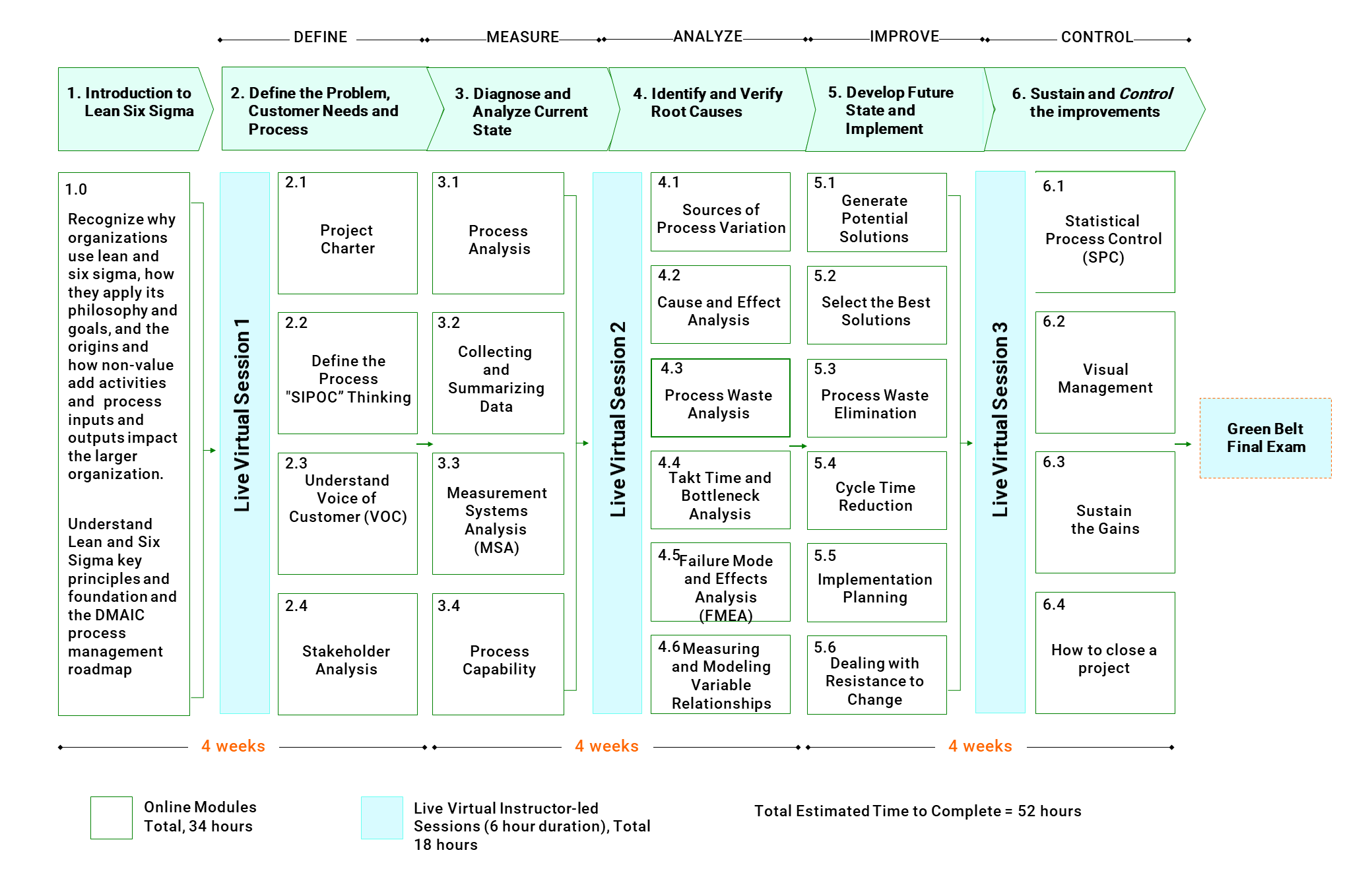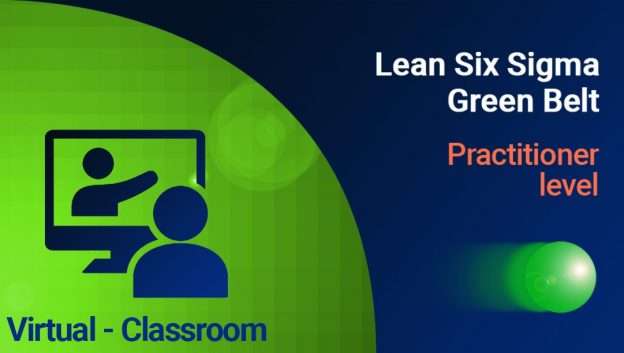
Lean Six Sigma Green Belt Training and Certification will take you on a hands-on learning journey that will help you develop the skills you need to create and implement actionable plans that can help your organization serve customers effectively and efficiently.
This Practitioner Level course sets out with an understanding of the fundamental principles of the Lean and Six Sigma, tools and techniques and the Define-Measure-Analyze-Improve-Control (DMAIC) process improvement roadmap. It focuses on how to collaborate to identify process waste, solve problems, manage change and implement significant and sustainable results.
By elevating your problem solving and analytical skills, you will return to work, able to develop and support a continuous improvement culture within your organization. A culture that is capable of confidently creating and sustaining innovative efforts.
How you benefit:
- Learn how to lead process improvement projects using Lean Six Sigma principles and toolkit using the Define-Measure-Analyze-Improve-Control (DMAIC) methodology
- Equipped to deliver customer satisfaction, business efficiency, on time and on quality productivity improvements in any organizational context
- Roadmaps for performance-oriented results: Access resources for creating vision and setting direction to guide individuals, teams and organizations to create a continuous improvement culture that is capable of confidently creating and sustaining improvement efforts
- Facilitate good decision making through the use of statistical data driven tools and techniques
- Acquire the mindset and skills to collaborate with others to identify waste, solve problems, manage change and implement significant and sustainable process improvements
- Return to work able to develop and support a continuous improvement culture within your organization.
Participant profile:
Green Belt Training and Certification is designed for team members, supervisors, project manager’s, functional and technical experts, consultants, senior executives from a wide variety of manufacturing, service and transactional organizations;
- Seeking to learn new problem solving approaches to develop and integrate cutting-edge best practices into their business processes and organizational culture.
- Participants coming in groups/teams to collaborate on Action Learning Project tailored to their organization’s context.
Course Pre-requisites
Interest in developing practitioner level continuous improvement skills
Exam and Certification
Online Exam: 30 questions
Duration: 40 min.
Pass mark: 70%
Achieve 70% pass mark in the Green Belt multiple choice final exam
Our Live Virtual Classroom courses leverage the power of technology to allow you to join from anywhere in the world to connect and engage live with instructor’s and peers just like in a classroom.
Featuring the same course content, world-class engaging, interactive teaching and diverse participants you can expect from face-to-face learning this new blended format includes virtual and online learning to deliver the insights and tools you need to bridge the gap between theory and real-life execution.
Delivered over 12 weeks that combines video lectures, real-life examples, discussions and quizzes to bring the key concepts to life. Each week of content follows a very clear path to facilitate learning for busy professionals. Our learning platform allows participants to learn at their own pace during each week, by viewing the content, completing assignments and engaging in discussions, taking on average 3-5 hours per week to complete.
Last but not least, the course provides a ready-made support network via our online learning platform where you can get in touch with Master Black Belt experts and fellow participants facing similar challenges.
The online material allows you to complete a significant portion of work flexibly – at your own pace, wherever you might be. Preparation completed online is then pulled into Live Virtual sessions, helping you make the most out of your time in class to apply the learning and to ensure you fully understand the topics.
- Purpose built instructional videos recorded in our media studio
- Interactive exercises and quizzes
- Cases, readings and additional resources
- Online discussions, guided by Master Black Belt’s and teaching assistants
As a course participant, you will complete approximately 34 hours of online material supported by virtual instructor led sessions. We have split each block of preparation into manageable chunks of time.
Throughout the online preparation modules, there are discussion points which will be drawn upon during the virtual classroom sessions, ensuring a direct connection between learning online and in the classroom.
There are 3 live Instructor-led Virtual Sessions, 6 hours duration each.
Like the other participants, you will bring your experiences to the classroom for in-depth and stimulating learning sessions with your fellow participants and Master Black Belt instructor’s, you will take a collaborative approach to the subject matter allowing you to;
- Consolidate knowledge and understanding
- Share your professional experience
- Master Black Belt instructor’s challenge your ideas
- Apply your knowledge to real-world cases
The core modules are structured progressively around the DMAIC methodology which allows you to apply learning from your course into the workplace rapidly. By accessing course materials at any time and leveraging the diversity of experience within your cohort, you’ll come up with innovative ideas and solutions to personalise the tools to your own situation and make an impact back at the workplace.
The breadth of topics covered in your core modules will give you the confidence to a clear set of priorities to create an action plan that can be used immediately upon your return at work.
- Make a positive impact to change and improvement projects at your workplace
- Adopt a learn by doing approach to apply learning outcomes to a real world scenario(s)
Curriculum and Course Format

1.0 INTRODUCTION TO LEAN SIX SIGMA
5 hours
Understand the value of lean and six sigma, its philosophy, history and goals and the rationale for combining the lean and six sigma approaches to apply to improvement projects.
Understand lean six sigma principles and foundation and the Define-Measure-Analyze-Improve-Control (DMAIC) process management roadmap.
Understand how non-value add activities and process inputs and outputs impact the larger organization.
1.01 Six Sigma DMAIC Overview
1.02 Process Variation
1.03 Six Sigma and Organizational Goals
1.04 The DMAIC Process Management Roadmap
1.05 Belt Structure for Skills Development
1.06 Summary – Six Sigma DMAIC Overview
1.07 Introduction to Lean
1.08 The Origin of Lean
1.09 Foundations of Lean
1.10 Value-add and Non-value-add Activities
1.11 Lean Mindset and Thinking
1.12 Summary – Introduction to Lean
1.13 Integration of Lean and Six Sigma to drive On- Time, On-Quality and On Cost performance
2.0 DEFINE
4 hours
Define the scope and goals of the improvement project in terms of customer and/or business requirements, the process that delivers these requirements and stakeholder needs.
2.01 Overview – Define Phase
2.02 Problem Definition and Project Charter
2.03 Define the Process – SIPOC Thinking
2.04 Understand Voice of Customer (VOC)
2.05 Customer Identification
2.06 Gather Customer Feedback
2.07 Analyze VOC Data
2.08 Define What is Critical to Quality (CTQ)
2.09 Summary – Understand Voice of Customer (VOC)
2.10 Stakeholder Analysis
2.11 Summary – Define Phase
3.0 MEASURE
6 hours
Map the process and measure, understand and baseline the current process performance and capability through a set of relevant and robust measures.
Calculate process performance metrics such as defects per unit (DPU), rolled throughput yield (RTY), cost of poor quality (COPQ), defects per million opportunities (DPMO) sigma levels and process capability indices.
3.01 Overview – Measure Phase
3.02 Process Analysis
3.03 Collecting and Summarizing Data
3.04 Types of Data and Measurement Scales
3.05 Evaluating Metrics
3.06 Data Collection Methods
3.07 Sampling Methods
3.08 Descriptive Statistics
3.09 Graphical Techniques
3.10 Summary – Collecting and Summarizing Data
3.11 Measurement Systems Analysis (MSA)
3.12 Process Capability
3.13 Process Capability Indices
3.14 Process Performance Indices
3.15 Short-term and Long-term Capability
3.16 Process Capability for Attribute data
3.17 Process Performance vs. Specification
3.18 Summary – Process Capability
3.19 Summary – Measure Phase
4.0 ANALYZE
6 hours
Analyze the gap between the current and desired performance, prioritise problems, process risk and identify root causes and understand / statistically verify their effect on process performance.
4.01 Overview – Analyze Phase
4.02 Sources of Process Variation
4.03 Cause and Effect Analysis
4.04 Process Waste Analysis
4.05 Takt Time and Bottleneck Analysis
4.06 Failure Mode and Effects Analysis (FMEA)
4.07 Measuring and Modeling Variable Relationships
4.08 Input and Output Variables
4.09 Correlation
4.10 Regression
4.11 Summary – Measuring and Modeling Variable Relationships
4.12 Summary – Analyze Phase
5.0 IMPROVE
4.5 hours
Generate, select and implement improvement solutions to fix the problems and prevent them from re-occurring so that the required performance goals are met.
Use concepts such as value chain, flow, pull, perfection, etc., and tools commonly used to eliminate waste, including kaizen, 5S, A3 problem solving, morning meetings etc.
5.01 Overview – Improve Phase
5.02 Generate Potential Solutions
5.03 Select the Best Solutions
5.04 Process Waste Elimination
5.05 Cycle Time Reduction
5.06 Implementation Planning
5.07 Dealing with Resistance to Change
5.08 Summary – Improve Phase
6.0 CONTROL
4.5 hours
Implement the improved process / solutions in a way that sustains and “holds the gains “and the process has robust control measures and a response plan.
The objectives and benefits of statistical process control (SPC) to track process performance and identify special and common causes.
6.01 Overview – Control Phase
6.02 Sustain the Gains
6.03 Documentation
6.04 Monitor Performance
6.05 Lessons Learned
6.06 Visual Management
6.07 Statistical Process Control (SPC)
6.08 How to close a project
6.09 Summary – Control Phase
Quizzes Segmented and embedded during and at the end of each DMAIC Phase
3.5 hours
Final Exam Lean Six Sigma Green Belt Certification
0.6 hours
Total Estimated Time to Complete Green Belt Training & Certification:
34 hours
Next Course Starting in
E-Learning Modules
34 Hours
Instructor-led Live Virtual Sessions
18 Hours
Dates
| Session 1 | Session 2 | Session 3 |
| 11th Jun – 2024 | 9th Jul – 2024 | 7th Aug – 2024 |
| 11th Sep – 2024 | 8th Oct – 2024 | 6th Nov – 2024 |
Virtual Instructor-led sessions take place live via Zoom between 09:30 to 15:30 BST / 08.30 to 14:30 UTC
Estimated time to complete
52 Hours
Course Fee (excluding VAT)
£ 1,875
What's Included
- 34 hours eLearning with Integrated Roadmaps and Quizzes (12 month access)
- Additional 18 hours Instructor-led Virtual Classroom
- 12 month free access to Green Belt Bootcamp Learning Platform, Toolkit, Case Studies and Downloadable Resources
- Green Belt Online Exam and Electronic Certificate
- Unlimited Practice Exams and Re-sits free of charge
- Email Tutor support via discussion groups





